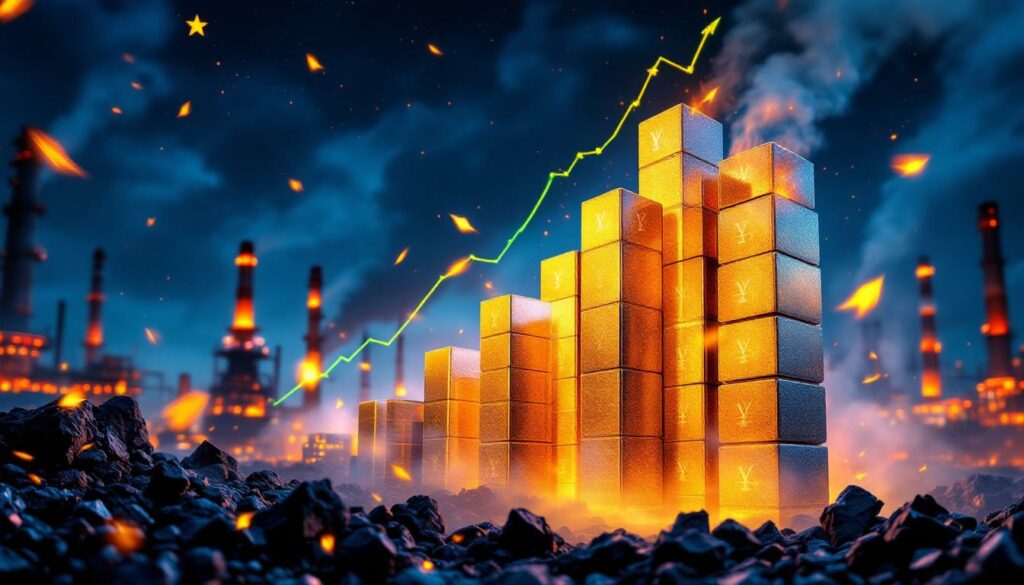Understanding the "Anti-Rat Race" Competition in China's Ferrous Metals Market
The ferrous metals industry in China is witnessing a significant shift in competitive dynamics, with what analysts are calling an "anti-rat race" movement gaining momentum. This strategic approach aims to end destructive price wars and create a more sustainable market environment through coordinated industry discipline.
What Defines the "Anti-Rat Race" Approach?
The "anti-rat race" competition represents a fundamental shift in China's ferrous metals sector. Rather than engaging in harmful price undercutting that damages the entire industry, market participants are embracing production discipline and strategic pricing to stabilize markets and preserve profitability.
This movement isn't happening in isolation—it's being actively supported through policy actions at both provincial and national levels. In Shanxi Province, for example, authorities have implemented crude steel production restrictions with an ambitious target reduction of 6 million metric tons. Meanwhile, China State Railway Group has canceled previous railway freight rate reductions for several railway bureaus, effectively increasing transportation costs and supporting price floors.
"The anti-rat race approach recognizes that when everyone races to the bottom on pricing, the entire industry suffers. Strategic coordination creates a healthier market where quality and efficiency—not just price—become competitive advantages," notes industry analysts familiar with the Chinese steel sector.
Environmental protection measures have also become a powerful tool in this movement, with targeted production limitations at facilities that fail to meet emissions standards. These restrictions create natural supply constraints that help prevent market oversupply and price collapse.
Raw Material Markets Respond Positively
The effects of the anti-rat race policies are particularly visible in raw material markets, where both iron ore and coke have shown remarkable resilience despite seasonal headwinds.
Iron Ore Defies Expectations
Iron ore has demonstrated strong upward momentum, with prices for PB fines at Shandong ports increasing by 15-20 yuan/mt month-over-month. Several factors are driving this strength:
- Supply pressure has eased as seasonal maintenance at overseas mines impacts global availability
- Steel mills maintaining good profitability levels are sustaining robust demand
- Port inventory patterns are showing narrow fluctuations, contradicting previous negative forecasts
- Market behavior is displaying inverse seasonal patterns that defy traditional expectations
The ongoing iron ore trends in China continue to influence the broader market dynamics significantly.
"Supported by good profitability of steel mills, pig iron production decline has been limited… disproving previously feared negative feedback logic," according to the SMM Iron Ore Analysis from July 11, 2025.
This resilience in iron ore markets signals that the anti-rat race approach is creating a more balanced supply-demand dynamic, where price stability replaces volatile boom-bust cycles.
Coke Market Shows Fundamental Strength
The coke market has similarly benefited from the anti-rat race environment, with prices maintaining stability across different grades:
- First-grade metallurgical coke (dry quenching): 1,440 yuan/mt
- Quasi-first-grade metallurgical coke (dry quenching): 1,300 yuan/mt
- First-grade metallurgical coke (wet quenching): 1,120 yuan/mt
- Quasi-first-grade metallurgical coke (wet quenching): 1,030 yuan/mt
Despite facing cost pressures, coking plants have managed to operate with sustainable losses while maintaining low inventory levels—a clear indicator of healthy underlying demand. Industry sources anticipate price increases in the coming weeks as production discipline continues to support market fundamentals.
Finished Steel Products Show Resilience
The positive effects of the anti-rat race competition are cascading through to finished steel products, with both rebar and hot rolled coil markets showing surprising strength.
Rebar Overcomes Seasonal Challenges
Rebar prices have demonstrated impressive upward momentum despite typical seasonal headwinds:
- The nationwide average price has reached 3,166 yuan/mt, representing a gain of 47.5 yuan/mt month-over-month
- Production at blast furnace steel mills decreased by 2.2% month-over-month in July, helping to balance supply
- Regional variations are evident, with southwest mills facing higher inventory pressure than coastal producers
- East China mills are strategically shifting production away from construction materials toward higher-margin products
While electric furnace steel mills have shown some improvement, they continue to operate at a loss with an operating rate of approximately 33.02%. High temperatures and rainfall have limited construction activity in many regions, creating seasonal demand constraints.
Hot Rolled Coil Maintains Momentum
Hot rolled coil (HRC) has shown even greater resilience than rebar, with a price pattern characterized by initial stabilization followed by strong upward movement. This positive trend is supported by:
- Improved trading atmosphere with increased weekly volumes
- Modest decrease in maintenance-related production limitations
- Strong demand resilience for sheets and plates despite seasonal factors
- Inventory decreases across most regions (east, north, south, and northeast China)
Only central China has shown a slight inventory buildup, contrary to the national trend. Cost support for HRC prices continues to strengthen from coke price stabilization and iron ore price increases, creating a solid foundation for sustained pricing power.
"HRC prices first stabilized weakly and then surged strongly… apparent demand showed an inverse seasonal increase," notes the SMM HRC Analysis from July 11, 2025.
Market Fundamentals Driving Positive Price Trajectories
The current market dynamics in China's ferrous metals sector reveal interesting contradictions in traditional supply-demand relationships, suggesting that the anti-rat race approach is creating new market patterns.
Supply-Demand Balance Shows Anomalies
Several notable anomalies in the supply-demand balance are worth examining:
- Pig iron production is bottoming out but showing resilience despite environmental restrictions
- Steel mill profitability remains adequate to maintain production enthusiasm
- Finished steel inventory is decreasing during what would typically be a seasonal buildup period
- The spot-futures price spread has narrowed significantly, attracting arbitrage and speculative demand
End-user demand continues to face limitations from high temperatures and rainfall in many regions, restricting purchases to as-needed basis. However, overall apparent demand is showing inverse seasonal patterns in several product categories, suggesting underlying strength in the market.
Cost Support Creates Price Floor
Multiple cost factors are providing significant upward pressure on prices throughout the ferrous metals chain:
- Raw materials (particularly iron ore and coking coal) are leading the price gains
- China Railway Group's freight rate policy changes are adding transportation costs
- Environmental compliance expenses continue to increase production costs
- Energy price increases in some regions are particularly affecting electric furnace operations
- Production restriction policies are creating artificial supply constraints
"Under the pressure of environmental protection-driven production restrictions, short-term pig iron production may continue to fluctuate… but cost support remains strong," according to SMM Fundamental Analysis from July 11, 2025.
The combination of these cost pressures creates a solid floor for prices that supports the anti-rat race mentality by discouraging unsustainable price cutting.
Technical and Sentiment Factors Add Momentum
Beyond fundamentals, both technical price patterns and shifting market sentiment are contributing to the positive momentum in ferrous metals markets.
Technical Price Analysis Shows Strength
From a technical perspective, the ferrous metals series is approaching significant levels that will test the sustainability of the current rally:
- Current prices are approaching the gap position established in early April
- The market has shown a pattern of initial stabilization followed by strong rallies
- Raw materials continue to lead the gains with finished products following
- Potential resistance exists at previous high points from earlier in the year
While there is some risk of technical corrections after rapid price increases, particularly in iron ore, the overall technical picture remains supportive of the anti-rat race narrative.
Market Sentiment Shows Notable Improvement
Market sentiment has shifted significantly in response to the anti-rat race policies:
- Previous market pessimism has improved under the combined support of policy expectations and raw material strength
- Participation has increased in both futures and spot markets
- Long-short arbitrage activity has grown as price spreads narrow
- Speculative demand has entered the market following key policy announcements
- Steel mills have shown improved willingness to purchase raw materials
"Beware of the risk of HRC prices jumping initially and then pulling back… currently dominated by capital sentiment," cautions the SMM HRC Technical Outlook from July 11, 2025.
This cautious optimism is tempered by awareness of potential technical corrections, creating a healthy balance in market expectations.
Future Outlook for China's Ferrous Metals Market
The immediate outlook for China's ferrous metals markets suggests continued strength, though with some nuances across different product categories.
Short-Term Price Projections
For the coming weeks, analysts anticipate:
- Iron ore prices may show sideways movement after recent rapid increases
- The coke market will likely operate steadily with potential price increases
- HRC futures could operate within the 3,180-3,340 yuan range
- Rebar prices will likely be driven primarily by sentiment rather than fundamentals
- Steel scrap faces limited upward momentum due to weak supply-demand patterns
Overall, the ferrous metals series is expected to maintain its recent gains in the near term, supported by the anti-rat race competitive dynamics. Current iron ore price forecast data suggests this trend may continue into the next quarter.
Critical Factors to Monitor
Several key factors will determine market direction in the coming weeks:
- The upcoming July Political Bureau meeting and potential policy announcements
- The end of seasonal maintenance at overseas mines affecting iron ore supply
- Coking plant price increase initiatives scheduled for next week
- Weather impacts on construction activity and scrap collection
- Technical resistance at the gap position from early April
- Potential profit-taking after recent price surges
- The sustainability of anti-rat race policy implementation
"Ferrous metals series prices may continue to hold up well next week, with attention paid to the pressure position of the gap above," according to the SMM Weekly Forecast from July 11, 2025.
Regional and Production Method Disparities
The anti-rat race environment is affecting different market segments in varied ways, creating both challenges and opportunities across regions and production methods.
Regional Market Variations
Performance varies significantly across different regions of China:
- East China: Good order-taking and profitability for variety materials, with strategic plans to reduce construction material production
- Southwest China: Steel mills facing high inventory pressure and more challenging market conditions
- Central China: Slight inventory buildup in HRC, contrary to the national trend of inventory reduction
- North, South, and Northeast China: Decreasing HRC inventories indicating healthy demand in these regions
Recent iron haulage update reports suggest that transportation efficiency improvements are helping to balance these regional disparities.
"East China mills… have plans to cut production of construction materials in July due to better margins on diversified products," notes the SMM Regional Analysis from July 11, 2025.
Production Method Performance Gaps
Different production methods are experiencing varied market conditions in the current environment:
- Blast furnace operations: Maintaining moderate profits and stable production levels
- Electric furnace operations: Improving but still in loss-making territory, with operating rates around 33.02%
- Single-product construction material manufacturers: Maintaining production enthusiasm despite market challenges
- Coking plants: Operating with manageable losses and stable production levels
These disparities highlight the uneven impact of the anti-rat race policies, with integrated producers generally faring better than specialty manufacturers.
Navigating Risks and Opportunities
The current market environment presents both significant risks and strategic opportunities for participants in China's ferrous metals sector.
Key Market Risks
Several factors could disrupt the current positive trajectory:
- Overreliance on sentiment rather than fundamentals could lead to sharp corrections if market psychology shifts
- Technical resistance at previous high points may limit upside potential in the near term
- Profit-taking after rapid price increases could trigger selling pressure
- Seasonal demand weakness from high temperatures and rainfall may persist longer than expected
- Potential policy shifts or implementation challenges with production restrictions could undermine the anti-rat race approach
"Overreliance on sentiment rather than fundamentals could lead to sharp corrections," warns the SMM Risk Advisory from July 11, 2025.
Strategic Opportunities
Despite these risks, the current market environment also presents several strategic opportunities:
- Cost-effective raw material purchasing ahead of expected price increases
- Long-short arbitrage as spot-futures price spreads narrow to attractive levels
- Strategic production adjustments to focus on higher-margin products
- Inventory management to capitalize on potential price increases
- Positioning ahead of potential policy announcements from the July Political Bureau meeting
The most successful market participants will balance these opportunities against the risks, maintaining flexibility to adapt to changing conditions while supporting the broader anti-rat race movement.
Understanding the Ferrous Metals Market: Key Questions Answered
What exactly is meant by "anti-rat race" competition?
The "anti-rat race" competition refers to coordinated industry efforts to prevent destructive price undercutting in China's ferrous metals sector. It includes policy measures like production restrictions, freight rate adjustments, and environmental regulations that help stabilize markets by preventing oversupply and unsustainable price competition.
Unlike traditional market dynamics where producers compete primarily on price—often driving prices below sustainable levels—the anti-rat race approach focuses on maintaining market discipline through production restraint and strategic pricing. This approach aligns with broader mining industry evolution trends toward sustainability.
How are production restrictions implemented in provinces like Shanxi?
Production restrictions in provinces like Shanxi involve setting specific reduction targets (such as the 6 million metric ton reduction in crude steel production) and issuing notices to steel mills. These restrictions are typically enforced through a combination of:
- Environmental inspections that identify non-compliant facilities
- Energy consumption limits that cap production potential
- Production quotas assigned to individual producers
- Financial penalties for exceeding authorized production levels
The effectiveness of these restrictions depends on consistent enforcement and industry compliance, both of which have improved in recent years.
What impact do railway freight rate changes have on the ferrous metals market?
Railway freight rate changes directly affect transportation costs for raw materials and finished products throughout the supply chain. The recent cancellation of reduced rates by China State Railway Group increases the cost basis for materials like coal and coke, providing upward price pressure that supports the anti-rat race environment.
These transportation cost increases are particularly significant for inland producers who rely heavily on rail transport to move materials to coastal markets. The resulting cost structure changes help prevent unsustainable price cutting by establishing a higher floor price.
How do seasonal factors affect ferrous metals prices?
Seasonal factors like high temperatures and rainfall typically reduce construction activity and end-user demand during summer months. However, the current market is showing inverse seasonal patterns in some areas, with inventory decreases during what would normally be a buildup period.
This unusual pattern suggests that the anti-rat race approach is creating new market dynamics that may be less susceptible to traditional seasonal fluctuations. Producers and traders should be cautious about relying too heavily on historical seasonal patterns in the current environment.
What is the relationship between raw material prices and finished steel products?
Raw material prices (particularly iron ore and coke) provide cost support for finished steel products. In the current market, raw materials are leading the price gains, with finished products following. This cost-push dynamic is reinforced by:
- Production restrictions limiting supply
- Environmental compliance costs increasing production expenses
- Transportation cost increases affecting the entire supply chain
- Energy price inflation in some regions
Understanding these cost relationships is essential for anticipating future price movements in the ferrous metals series. Analysts continue to monitor iron ore demand insights for early indicators of market direction.
Conclusion: The Future of the Anti-Rat Race Approach
The anti-rat race competition in China's ferrous metals market represents a significant shift in industry dynamics, with potentially lasting implications for market structure, pricing patterns, and competitive strategies. By prioritizing market stability over destructive price competition, this approach could create a more sustainable environment for all participants.
However, the success of this approach depends on continued policy support, industry discipline, and balanced market fundamentals. As the market navigates the coming months, the resilience of the anti-rat race movement will be tested by changing seasonal patterns, policy developments, and global market forces.
For market participants, adapting to this new competitive landscape requires strategic flexibility, careful cost management, and a willingness to prioritize long-term sustainability over short-term market share gains. Those who successfully navigate these changes may find opportunities for improved profitability and more stable business conditions in China's evolving ferrous metals sector.
Ready to Stay Ahead of Mineral Discovery Movements?
Discover significant ASX mineral discoveries as they happen with Discovery Alert's proprietary Discovery IQ model, turning complex mining data into actionable investment insights. Explore how major mineral discoveries can lead to substantial market returns by visiting Discovery Alert's dedicated discoveries page and start your 30-day free trial today to position yourself ahead of the market.




